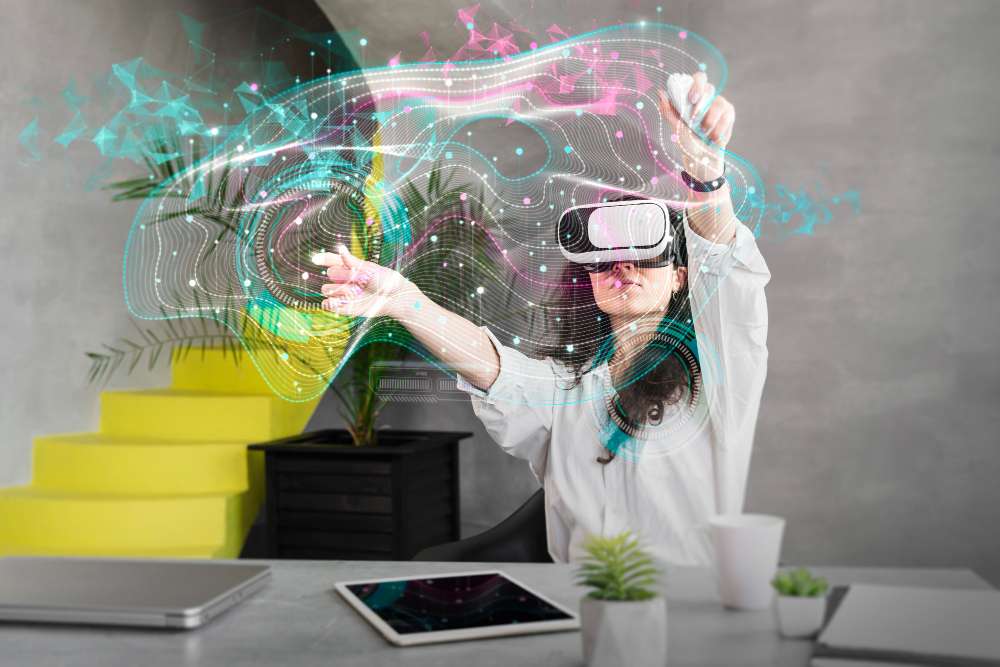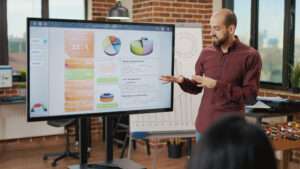As we venture into 2023, the rapid pace of technological advancements continues to reshape the world around us. From groundbreaking innovations in artificial intelligence to transformative developments in blockchain and quantum computing, staying informed about the latest technology trends is crucial. In this blog, we present the top 18 new technology trends that are set to redefine industries and impact our lives in 2023. From automation and robotics to augmented reality and sustainable technologies, we’ll explore the exciting advancements that lie ahead.
Table of Contents
- Artificial Intelligence (AI) and Machine Learning (ML)
- Internet of Things (IoT) and Edge Computing
- 5G and Next-Generation Connectivity
- Quantum Computing
- Extended Reality (XR): AR, VR, MR
- Blockchain and Cryptocurrencies
- Cybersecurity and Privacy Enhancements
- Autonomous Vehicles and Advanced Driver-Assistance Systems (ADAS)
- Biotechnology and Genetic Engineering
- Renewable Energy and Sustainable Technologies
- Robotics and Automation
- Voice and Natural Language Processing
- Human-Machine Interaction and Brain-Computer Interfaces
- 3D Printing and Additive Manufacturing
- Edge AI and Federated Learning
- Hyperautomation and Robotic Process Automation (RPA)
- Space Exploration and Commercial Space Travel
- Digital Twins and Simulation Technologies
Artificial Intelligence (AI) and Machine Learning (ML)
AI and ML are transforming industries by enabling machines to learn, adapt, and perform tasks that typically require human intelligence. AI algorithms and ML models are being applied in various domains, including healthcare, finance, and customer service, to automate processes, make predictions, and derive insights from vast amounts of data. As AI and ML continue to advance, they have the potential to revolutionize how we work, live, and interact with technology.
Internet of Things (IoT) and Edge Computing
IoT refers to the network of interconnected devices that communicate and exchange data. By integrating sensors, actuators, and connectivity, IoT enables remote monitoring, control, and automation of devices and systems. Edge computing, on the other hand, involves processing and analyzing data closer to the source, reducing latency and enhancing real-time decision-making. Together, IoT and edge computing pave the way for smart homes, smart cities, and efficient industrial operations.
5G and Next-Generation Connectivity
5G, the fifth-generation wireless technology, promises faster speeds, lower latency, and greater network capacity. It facilitates faster data transfer, enhances communication between devices, and enables the seamless integration of technologies like IoT, AI, and VR. With 5G, we can expect advancements in areas such as autonomous vehicles, remote surgery, and immersive experiences.
Quantum Computing
Quantum computing utilizes quantum bits or qubits to perform complex computations. It has the potential to solve problems that are beyond the capabilities of classical computers. Quantum computing can revolutionize fields like cryptography, drug discovery, optimization, and climate modeling. While still in its early stages, ongoing research and development in quantum computing hold promise for solving complex challenges and driving scientific breakthroughs.
Extended Reality (XR): AR, VR, MR
Extended Reality (XR) encompasses Augmented Reality (AR), Virtual Reality (VR), and Mixed Reality (MR). AR overlays digital information onto the real world, VR creates immersive virtual environments, and MR blends virtual and real elements. XR technologies have applications in gaming, training, healthcare, and architecture, offering interactive and immersive experiences. As XR continues to evolve, we can anticipate more realistic simulations and transformative user experiences.
Blockchain and Cryptocurrencies
Blockchain technology provides a decentralized and transparent platform for secure transactions and data storage. It offers immense potential across various sectors, including finance, supply chain management, and healthcare. Cryptocurrencies, such as Bitcoin and Ethereum, are digital assets that utilize blockchain technology for secure and efficient peer-to-peer transactions. The adoption of blockchain and cryptocurrencies is driving innovation, eliminating intermediaries, and revolutionizing traditional business models.
Cybersecurity and Privacy Enhancements
With the increasing digitization of our lives, cybersecurity and privacy have become paramount. Advancements in technologies like encryption, biometrics, and behavioral analytics are strengthening security measures. Additionally, regulations and frameworks are being developed to protect user privacy and data. The focus on cybersecurity and privacy enhancements aims to safeguard personal information, prevent data breaches, and ensure trust in digital ecosystems.
Autonomous Vehicles and Advanced Driver-Assistance Systems (ADAS)
Autonomous vehicles, including self-driving cars, are poised to transform transportation. Through the integration of AI, sensors, and advanced algorithms, these vehicles can navigate and operate without human intervention. Advanced Driver-Assistance Systems (ADAS) provide features such as lane-keeping, adaptive cruise control, and collision avoidance, enhancing safety and efficiency. The development of autonomous vehicles and ADAS technologies has the potential to revolutionize mobility, reduce accidents, and improve traffic management.
Biotechnology and Genetic Engineering
Biotechnology and genetic engineering are unlocking new possibilities in healthcare, agriculture, and environmental conservation. Advances in gene editing tools like CRISPR-Cas9 allow for precise modification of genetic material, offering potential treatments for genetic diseases. Biotechnology is also transforming agriculture through genetically modified crops with enhanced traits. Moreover, biotech innovations contribute to sustainable practices by enabling the production of biofuels, biodegradable materials, and clean technologies.
Renewable Energy and Sustainable Technologies
The pursuit of renewable energy and sustainable technologies is vital for addressing climate change and achieving environmental sustainability. Innovations in solar, wind, hydro, and geothermal power are making renewable energy sources more efficient and cost-effective. Additionally, sustainable technologies focus on resource conservation, waste reduction, and eco-friendly practices. The adoption of renewable energy and sustainable technologies is driving the transition to a greener future, reducing greenhouse gas emissions, and promoting environmental stewardship.
Robotics and Automation
Robotics and automation involve the use of machines and software to automate tasks, increasing productivity and efficiency. Robots are being employed in industries such as manufacturing, healthcare, and logistics to perform repetitive or dangerous tasks, leading to improved accuracy and reduced human error. Automation technologies like robotic process automation (RPA) streamline workflows, optimize resource allocation, and enhance operational processes.
Voice and Natural Language Processing
Voice and natural language processing (NLP) technologies enable machines to understand and interpret human language. Virtual assistants, chatbots, and voice-enabled devices leverage NLP to provide interactive and intuitive user experiences. Voice and NLP advancements facilitate voice commands, language translation, sentiment analysis, and personalized recommendations, transforming how we interact with technology and access information.
Human-Machine Interaction and Brain-Computer Interfaces
Human-machine interaction focuses on developing interfaces that enable seamless interaction between humans and machines. Brain-computer interfaces (BCIs) bridge the gap between the human brain and technology, allowing direct communication and control. BCIs have applications in healthcare, rehabilitation, and assistive technologies. Advancements in this field are enhancing the integration and collaboration between humans and machines, opening up new possibilities for communication and control.
3D Printing and Additive Manufacturing
3D printing, or additive manufacturing, enables the creation of three-dimensional objects by layering materials based on digital designs. This technology has revolutionized manufacturing processes, prototyping, and customization. It offers benefits such as reduced waste, increased design flexibility, and cost-effective production. 3D printing finds applications in various industries, including healthcare, aerospace, and automotive, allowing for complex geometries and on-demand production.
Edge AI and Federated Learning
Edge AI involves the deployment of artificial intelligence algorithms and models on edge devices, closer to the data source. This enables real-time processing, reduced latency, and enhanced privacy. Federated learning, a distributed learning approach, allows multiple devices to collaboratively train AI models without sharing raw data. Edge AI and federated learning are poised to drive advancements in areas like autonomous vehicles, Internet of Things (IoT), and personalized experiences.
Hyperautomation and Robotic Process Automation (RPA)
Hyperautomation refers to the integration of multiple automation technologies, including RPA, artificial intelligence, machine learning, and process mining. It aims to automate and optimize end-to-end business processes, enhancing efficiency, accuracy, and scalability. RPA enables the automation of repetitive, rule-based tasks, freeing up human resources for higher-value activities. Hyperautomation empowers organizations to streamline operations, improve customer experiences, and drive digital transformation.
Space Exploration and Commercial Space Travel
Advancements in space exploration and commercial space travel are opening up new frontiers for scientific research, tourism, and satellite deployment. Private companies are developing reusable rockets and spacecraft, reducing costs and increasing accessibility to space. Space exploration missions aim to uncover mysteries of the universe, while commercial space travel endeavors to make space tourism a reality. These advancements have the potential to revolutionize our understanding of space and open up opportunities beyond Earth.
Digital Twins and Simulation Technologies
Digital twins are virtual replicas of physical objects, systems, or processes. They enable real-time monitoring, analysis, and optimization of physical assets and processes. Simulation technologies utilize digital twins to model and simulate complex systems, providing insights and predicting outcomes. Digital twins and simulation technologies find applications in industries like manufacturing, healthcare, and urban planning. They enable predictive maintenance, performance optimization, and risk assessment, enhancing efficiency and decision-making processes.
In Final Thought
As we delve into 2023, the new technology trends outlined in this blog present an exciting glimpse into the future. From the transformative potential of AI and blockchain to the endless possibilities of XR and quantum computing, these innovations are set to shape industries, improve our lives, and drive societal progress. Embracing these technologies requires ongoing learning and adaptability, enabling us to leverage their potential to the fullest. As we navigate the evolving technological landscape, let us embrace the opportunities presented by these trends and actively participate in the ongoing digital revolution. The future is here, and by staying informed and proactive, we can harness the power of these emerging technologies for a brighter and more innovative tomorrow.





